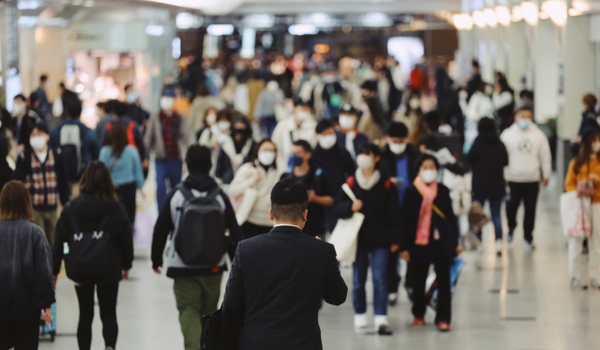


CALIFORNIA - A remarkable 900 million Chinese have now contracted COVID-19 - that is the most recent number reported by Peking University.
This number was calculated in part from hospital and crematorium records - generally a fairly reliable source. Now, after the astronomical levels of infections in December and January, things seem to be calming down at last. This is a huge relief considering the constant crush of patients being admitted to healthcare facilities and the shortage of life-saving drugs, physicians, and nurses. In fact, it is now being reported that China’s death tolls are just half of what they were in January. Even leading scientific journal Nature reports that the winter COVID-19 surge in China has most likely already peaked.
Surprisingly, the Chinese Lunar New Year - which was expected to increase the rate of COVID-19 cases due to the estimated 226 million trips that were taken - did not have much of an effect. As a result, the rate of new cases has now plummeted, but China is not yet out of the woods. Until the population has experienced multiple bouts of infection and has gotten regular booster shots, China is unlikely to be able to weather COVID-19 surges as well as other countries.
The most recent wave of Covid-19 infections has itself functioned as a booster of sorts, giving much needed antibodies and thus immunity to those fortunate enough to recover to full health after catching the virus. Because China’s population had a low uptake of the latest booster, many people became infected during the most recent surge - a whopping 80 percent of people in Beijing were infected - but because most Chinese people had at least received a primary series of shots, some were still protected from severe disease. Although this staggeringly high infection rate caused a tsunami of cases that placed severe stress on health systems, and many people died as a result, the silver lining to all this is that much of the population is now protected, at least until their antibodies begin to wane later this spring or early this summer. This begs the question, what should China do to mitigate the impact of another wave of infections, which will almost inevitably occur in the next four to six months after the last wave once the level of antibodies in the population starts to dip?
China is using technology to help predict the next surge by applying the known science on antibodies to active policy. In developed countries such as the United States, testing for antibody levels has been widely disregarded as a useful method of tracking population metrics and identifying potential surges. The US Centers for Disease Control and Prevention (CDC) has not publicly announced a ‘threshold’ for which a certain level of antibodies indicates more potential for infection, but that does not mean the science is not there. There are several well-known epidemiologists who are mapping antibody levels to infection rates and to severity of infection. Their findings clearly indicate that, in most healthy individuals, higher antibody levels will lead to both a lower chance of infection in the first place, and, if infection does occur, to a more efficacious clearing of the virus and recovery, lowering the chances of developing long COVID.
These findings corroborate the empirical data, which shows evidence that when one has recently been infected or vaccinated, one is less likely to be infected for several months, most likely due to a heightened immune response from higher antibody levels. Currently, antibody levels are usually measured using blood tests, but they can also be measured by just a finger prick, which makes testing both cheap and accessible, since it does not necessarily need to be run through a lab. This then allows widespread antibody testing to be conducted with little inconvenience to the individual, but with potentially enormous benefits to the population. Also, consistent antibody testing could also help dictate a more clinically appropriate time for encouraging individuals to get vaccinated and boosted.
Big picture
China is smart to be taking these findings and the resulting antibody technology to the next level. The country is enrolling cohorts of Chinese in antibody studies where they regularly look at antibody levels and when, on average, the levels of antibodies in the general population start to dip. This is done by aggregating antibody data into a central database. Of course, antibody levels in the population at large do not necessarily dictate a specific person’s antibody levels, but by measuring at the population level, authorities can better predict the likelihood of a community surge and thereby prepare healthcare workers and health facilities, while also knowing when to start encouraging mitigation behaviors such as masking, vaccination, and social distancing. Thus, even though China has significantly reduced restrictions by eliminating lockdowns for the time being, that does not mean the country is taking a ‘free-for-all’ approach to monitoring. Instead, officials are developing calculated measures to sophisticatedly track the spread of the virus using new technology and centralized data collection.
Another way China is monitoring cases is by translating web searches into powerful predictive algorithms. That way, whenever someone searches a specific word that triggers an alert - such as ‘fever’ - the system collects those data. Then, when those key searches reach a certain number, the government can be alerted that there might be a new surge coming. Search engine mining is not a new technology, but when layered with other novel data collection measures, like data migration maps - which track large movements of people - the Chinese government can begin to paint an accurate picture of future COVID-19 case development.
This is important because historical models that other countries have used to predict when future case surges will hit are not necessarily directly applicable to China. In part, this is because the SARS-COV-2 variants that are circulating have changed substantially since a large country was infected on the scale that people in China were infected during the last two months. This makes older predictive models less useful, because not only has the virus itself changed, but the R-zero - the number of subsequent infections likely to result from one infection - has shifted as well. Additionally, the Chinese population still lacks the herd immunity present in other countries, which compounds the problem further.
To understand new changes in viral patterns, China’s own CDC has invested in developing genetic analytics to detect both changes in viral variants and to detect suspected cases more quickly, reducing the time needed to do this from 55 minutes to 27 seconds. Furthermore, there is now infrared artificial intelligence (AI) technology that can be used to screen the body temperatures of large numbers of people and identify those who may have fevers.
China would be wise to continue on its path of leveraging innovation not only to predict and mitigate future surges, but also to treat the sick more effectively with evidenced-based treatments - many of which are supported by AI, data science, and novel technology.
References:
1. https://www.globaltimes.cn/page/202302/1284873.shtml
2. https://www.bbc.com/news/world-asia-china-64449226
The content herein is subject to copyright by The Yuan. All rights reserved. The content of the services is owned or licensed to The Yuan. Such content from The Yuan may be shared and reprinted but must clearly identify The Yuan as its original source. Content from a third-party copyright holder identified in the copyright notice contained in such third party’s content appearing in The Yuan must likewise be clearly labeled as such. Continue with Linkedin
Continue with Linkedin
 Continue with Google
Continue with Google










 1139 views
1139 views







